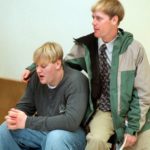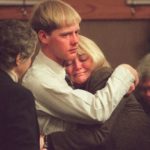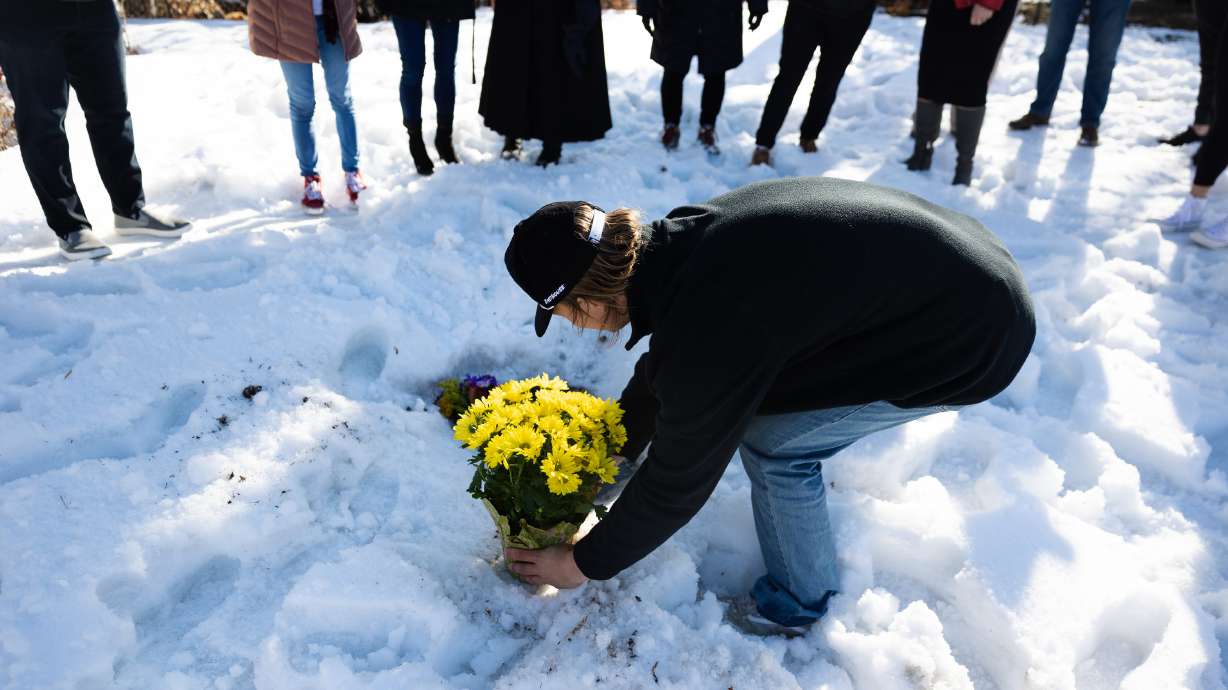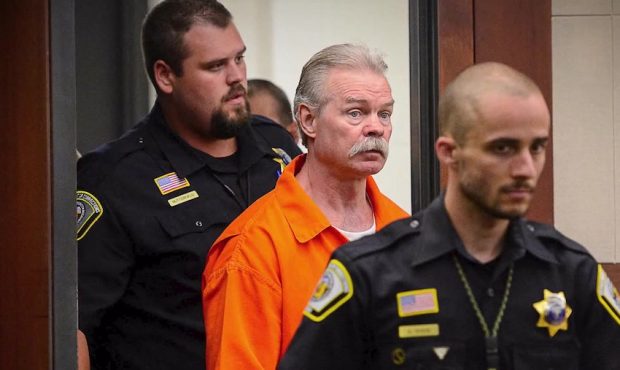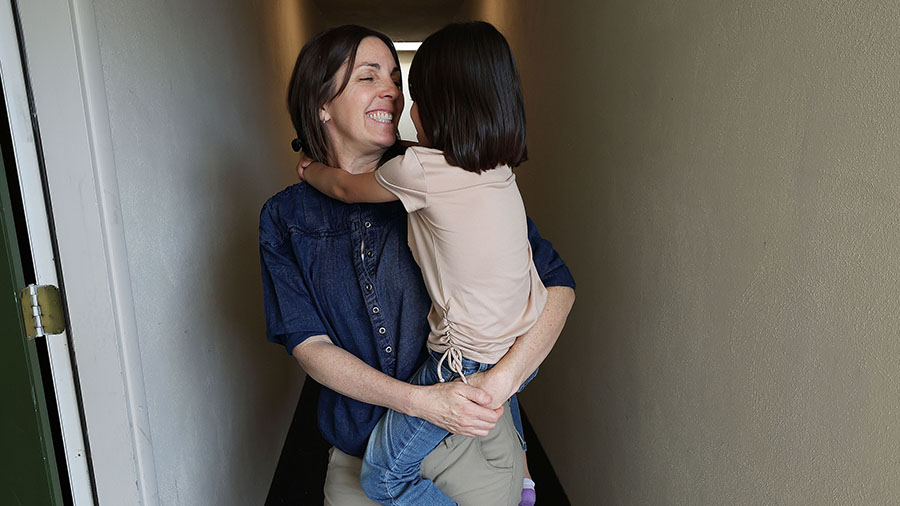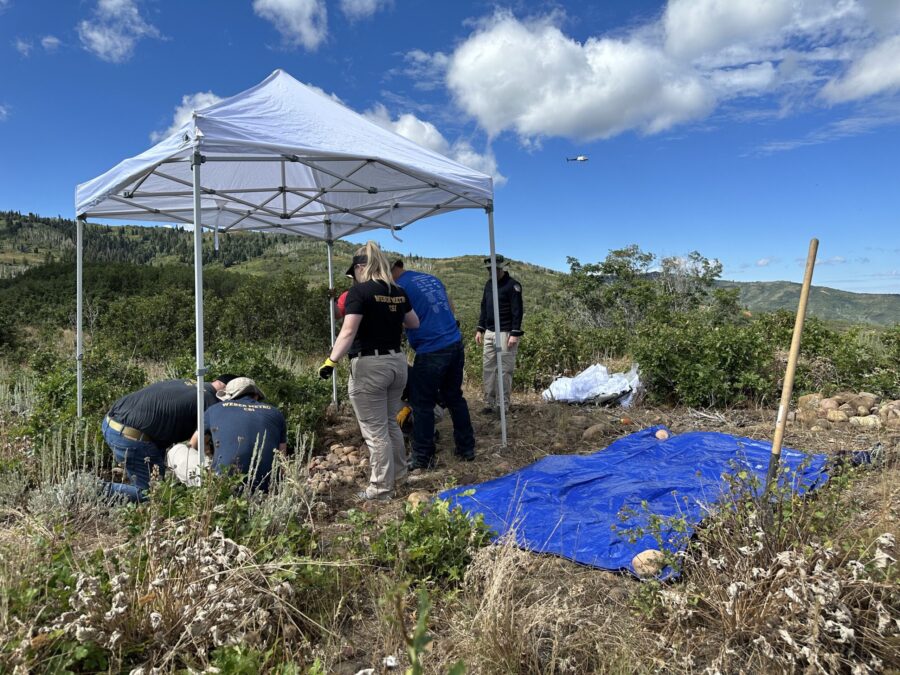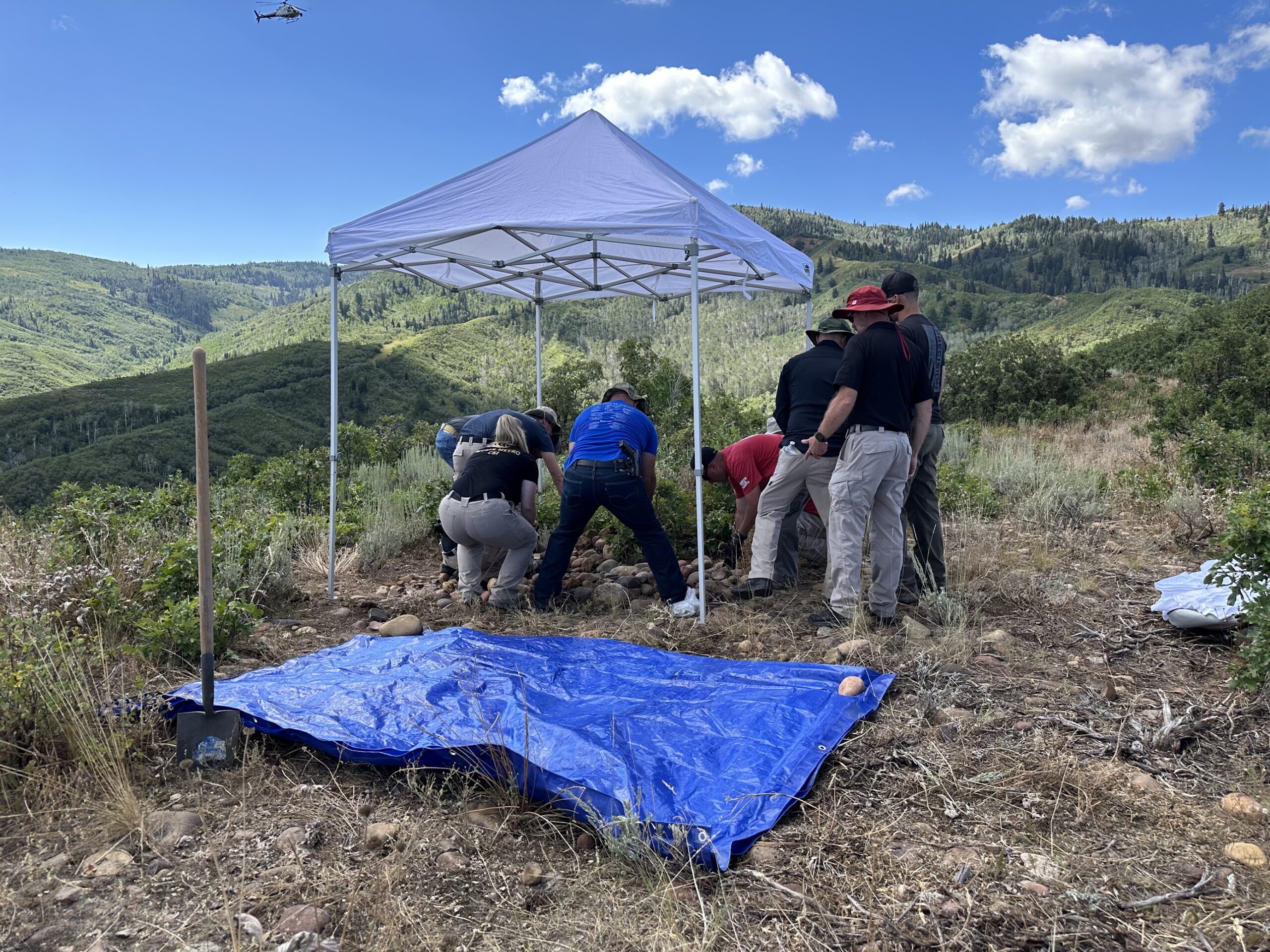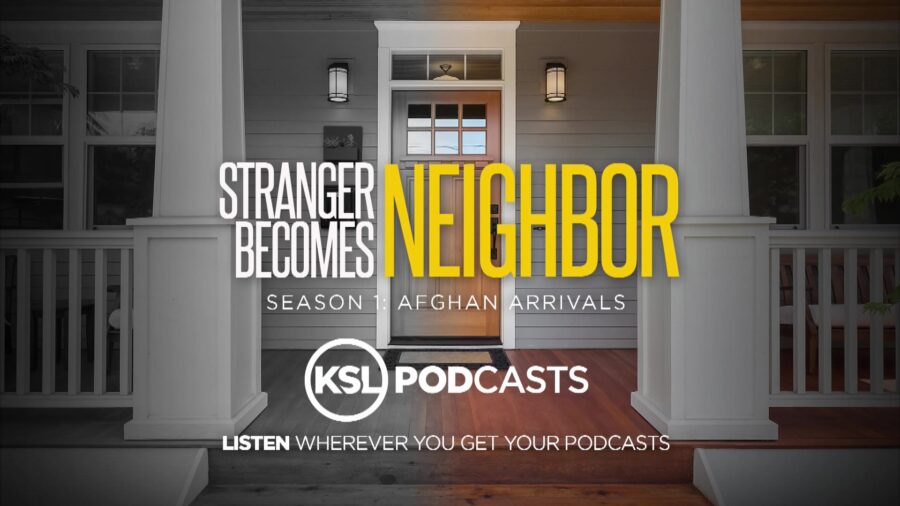‘The Letter’: A death sentence waiting to happen
Sep 20, 2022, 1:25 PM | Updated: Nov 18, 2022, 10:53 pm
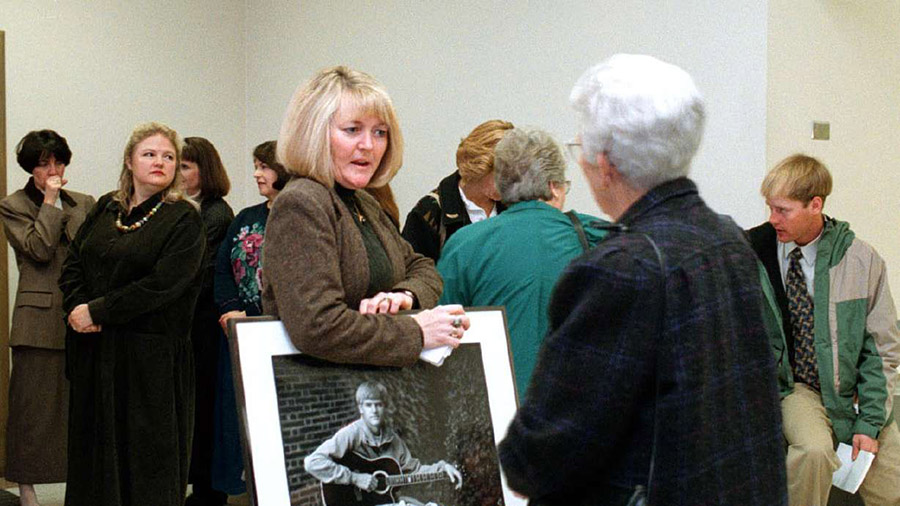
Family members gather outside a courtroom where Jorge Benvenuto was sentenced for murder on Jan. 30, 1998. Sy Snarr, Zach Snarr's mother, holds a large picture of her son. Episode 4 of "The Letter" podcast looks back at the sentencing hearing. (Kristan Jacobsen, Deseret News)
(Kristan Jacobsen, Deseret News)
Editor’s note: This is the fourth in a series highlighting a KSL podcast series titled “The Letter.” It explores the many aspects of grief, the realities of reclaiming lives shattered by violence and the possibilities of forgiveness stemming from a 1996 Utah murder that veteran police detectives said was unlike any other they had ever investigated.
SALT LAKE CITY — Sy Snarr tried to focus on her husband’s face and what he was trying to tell her as she fought her way out of a sleepy haze.
“I had actually been up for so long,” Snarr said trying to recall the hours after her son was murdered in 1996. “They tell me I was standing there and all of a sudden, I just passed out on the floor. They had put me in bed, and then my husband came in and said, ‘They got him. They got him.'”
As the pain yanked her back into the reality of her son being shot by a stranger while on a date with a long-time friend, she realized what he was saying.
“I was, like, coming to,” she recalled, “and I’m like, ‘What?’ And then it hit me. … They got him!”
A short time later, prosecutor Bob Stott arrived at their Salt Lake home to meet with the family and try to answer some of their questions about the arrest of 19-year-old Jorge Benvenuto, who had confessed to shooting their son Zachary Snarr and Yvette Rodier, both 18.
“I just looked at him and said, ‘Kill him,'” she said. “I actually said that. Because I thought, ‘He deserves to die.’ I wanted him to die.”
Snarr wasn’t alone.
Almost everyone involved felt like if there was ever a case that cried out for the death penalty, it was this one — the unprovoked, random attack of two teenagers who were just enjoying a summer night taking pictures of the moon at Little Dell Reservoir.
“It was just a very bad fact situation,” said prosecutor Roger Blaylock, who worked the case with Stott. “And by bad I don’t mean for a prosecutor. It’s a good situation (for prosecutors), because it’s so terrible. Here are two young people up at the reservoir, just kind of taking pictures of the moon and somebody comes up and shoots them both. … What is there about the defendant that is socially redeeming?”
Inevitable death sentence?
Benvenuto couldn’t afford his own attorney, so the case was assigned to the Salt Lake Legal Defender’s Office. Mark Moffat was one of the attorneys assigned to the case, and right from the start, he said they felt like the deck was stacked against them.
“I just remember when … the shooting occurred,” he said, “it shook the community. We had two young kids that were up there doing an innocent thing … in the mountains, where everybody in the community went from time to time, everybody goes up in the mountains to hike or, you know, get away. And there was just something about that case that freaked the community out.”
Add to the circumstances that Rodier had survived to offer a terrifyingly detailed account of what happened. And their client had confessed.
The crime also occurred at the height of the “tough on crime” stance a lot of communities embraced in the 1990s. There was a long list of legislation passed, both locally and at the federal level, aimed at creating tougher penalties for violent crimes. From gun and gang enhancements to laws that sent juvenile offenders straight into the adult criminal justice system, the attitude of everyone was to protect society by punishing offenders as severely as possible.
Moffat also worried that a jury made up of typical Utahns wouldn’t relate to the struggles of an immigrant from Uruguay.
“One of the things that we thought was (a) positive for us was Jorge’s age,” Moffat recalled. “But given everything else that was going on, with who he was and what he had done, we just felt it was going to be a death sentence.”
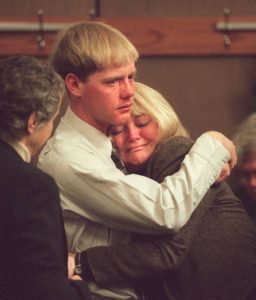
Sy Snarr and her son Trent Snarr, 23, hug after the sentencing of Jorge Benvenuto in the killing of their son and brother, Zachary Snarr, on Jan. 30, 1998. (Photo: Kristan Jacobsen, Deseret News)
When Benvenuto was charged with aggravated murder, attempted aggravated murder and two counts of robbery, both families supported the initial effort of prosecutors seeking the death penalty.
It wasn’t until Snarr heard the medical examiner testify that she realized she might not be able to listen to the details about how her son died if the case went to trial.
“The day the medical examiner testified, I think, was the worst day of my life,” she said. “Because she did show a drawing of Zach and talked about where he shot him and … after he’d shot him twice, he actually held the gun point-blank to his head. And I had not known that. And that really affected me. It did. And I had driven myself down there, and I literally had to pull over; I could not drive home because I was wailing, sobbing. It really — it just killed me that that had happened to that beautiful boy of mine, you know, that his life ended that way. It was hard.”
Then she was watching a news report of a killing in Kearns, and she realized this was going to be much more difficult than she understood.
“They were showing drawings of this person’s body showing where she had been stabbed over and over,” she said of the news report. “And I thought, ‘I cannot watch this on TV about Zach, I can’t do it.'”
A friend of the family, who was also a state senator, worked with prosecutors and corrections officials to arrange a tour of the Utah State Prison for the Snarrs. After the tour, they agreed to a deal that would spare Benvenuto’s life but would keep him in prison for the rest of his life. The deal took advantage of a law passed in 1992 that gave prosecutors another option in capital murder cases — life in prison without the possibility of parole.
Zach’s older sister, Sydney, was out of state when the family toured the prison, but her family told her what they’d seen afterward.
“My older brother Trent said that it gave him nightmares,” Sydney Snarr Davis said. “It was so awful, and I remember him telling me that I think I would rather die than live the rest of my life in that hellhole. And at that point, I was like, ‘Well then, good. Do it.’ You know, let’s forget about him. He can go in there and rot.”
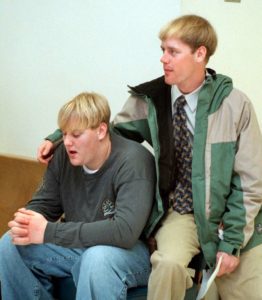
Zach Snarr’s brothers, Levi, 17, (left) and Trent, 23 wait outside courtroom for sentencing of Jorge Benvenuto in 1996. (Photo: Kristan Jacobsen, Deseret News)
Rodier, who got married about 10 months after the shooting, said she didn’t think Benvenuto’s punishment was her decision to make, although she acknowledges her family hoped he’d get the death penalty.
“I don’t recall thinking about it at that time,” she said. “I definitely knew I was afraid of him. And so if there was something that would keep him away from me, I was all for it. But I, I don’t think I ever wished death upon him.”
Moffat said Benvenuto vacillated about whether he wanted take the deal, or take his chances with a jury, until moments before he entered a guilty plea in October of 1997.
“Keep in mind, when you do death penalty work, there are people that you come to know, as we call them, volunteers, who basically say, I’m not going to fight. … And Jorge was, on certain days, a volunteer. Other days, not. I mean, he vacillated and it made these discussions really hard. … And, they continued right up until the moments before the plea.”
After Benvenuto entered a guilty plea, he fired his defense attorneys and his family hired two private lawyers. Those men appeared with Benvenuto for the sentencing in January 1998. The hearing was a formality, but the change in legal representation indicated there might be a change in legal strategy.
Still, the judge had accepted the guilty plea and then Rodier and members of the Snarr family spoke before Benvenuto was sentenced without offering a word of apology, explanation or defense of himself.
‘I was alone that night’
“I need to know that the murderer will never walk free,” Sy Snarr told the judge. “He made a terrible choice. Now he must pay the consequences for that choice. We need some closure. Our family needs to get on with our lives. Yvette needs to get on with her life. But we cannot do that until we know that we and everyone else are safe.”
Yvette’s mother, Linda Rodier, who died in 2018, said Benvenuto’s actions didn’t just end one life.
“I think it’s important that the court know — and that everyone here know — that on Aug. 28, 1996, Mr. Benvenuto killed two people,” she said. “We miss a part of Yvette that will never be here. She cannot be alone. There is a part of her that is dead, and I don’t know that it will ever be returned to us.”
And then Yvette Rodier stood and read a statement that she wrote. It is the first time she offered insight into the complicated nature of her recovery. Until this moment, she’d been answering reporters’ questions or offering police details of a crime. At 19, she stood and told the world what she had faced — and it was a powerful moment.
“On Aug. 28 1996, the word that describes that night the most is alone,” she said. “I was with my dearest closest friend and he was murdered right next to me. It’s hard to describe the feelings that go through your mind when you know that someone that you love dearly is lying dead beside you. I was shot many times, I don’t know how many. I’ve got the scars to prove it. But I was alone that night, after a person who had just murdered my friend rummaged through my clothing, and I could feel his hands on my body.
“I was alone.”
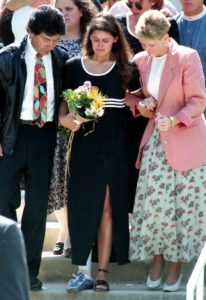
An injured Yvette Rodier is helped down a flight of stairs after the funeral of her friend Zach Snarr, who was shot and killed on Aug 28, 1996, at Little Dell Reservoir. (Photo: Jeffrey D. Allred, Deseret News)
She described the painful gunshot wounds, the ringing in her ears, the fog in her brain.
“I guess you really don’t know what happens until after, but I remember it all,” she said. “There is nothing that I have forgotten. And I don’t know if I will ever forget. Since that night, my body has basically been ripped apart again. I’ve had five operations, one more to come. Most of them on my head, opening my head, taking pieces out, putting them back in.”
She talked about chronic pain, about the surgeries and the impact on her family.
“It’s the psychological pain that I think has hurt the most,” she said. “I know what depression is. I know because I have suffered in many days. I think a lot of it has to come from survivor’s guilt. I know that’s a clinical term but I feel guilty that Zack died. And I don’t know if the person who has done this does. I sure hope so. But I didn’t try CPR. I know CPR. Why didn’t I do it? I didn’t try to hold his wounds or hold him tight. I couldn’t remember his family’s phone number in the operating room … I call that phone number almost every day and I couldn’t remember it.
“I hate dealing with the guilt. It’s so unfair. I hate that feeling. A lot of my psychological pain is fear. I’m afraid to cross the street. I’m afraid someone is attacking me. I’m afraid someone is stalking me. I’m afraid of nighttime. I’m afraid of gunshots on the television. My whole family’s had to alter their life so I wouldn’t have to be alone by myself. I’m too afraid of my fears.
“I don’t sleep. I have horrible nightmares that I die or the people I love die. I think part of a lot of the psychological stuff is that I know that when he stopped that shooting and reloaded, that he was aiming right at me.”
And then she continued: “Zach and I are not the only victims here. Our families and friends, our communities are, too. It’s not just us we need to have justice for. It’s for all of us around us. I just, I know that I have a family who loves me and protects me and takes care of me. And I’m thankful for that. Because I don’t think I would be strong enough to stand today and say how much this has hurt me. But out of all this, I can deal with it. I’m alive. I can wake up tomorrow. I’m lucky. But Zach never will.”
‘I was so naive’
Judge Anne Stirba, who passed away in 2001, was deeply moved by the outpouring of love for Zach Snarr and for Yvette Rodier’s moving plea for justice.
She told Benvenuto he would never really understand what he’d done because he’d never be a parent.
“I cannot imagine the pain of losing a child,” Stirba said. “You will never know what it is to have a child or to lose a child. Mr Benvenuto, I don’t think you will ever know the pain, the full extent, the full measure of pain which you have caused.”
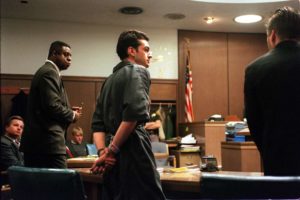
Jorge Benvenuto walks to the front of the courtroom with his lawyers during sentencing for the murder of Zachary Snarr on Jan. 30, 1998. (Photo: Kristan Jacobsen, Deseret News)
The judge expressed admiration for Rodier.
“What Yvette is today, she is because of her own incredible courage, and her strength and her will to heal, despite what you took from her,” she said.
And then Stirba sentenced Benvenuto to spend the rest of his natural life behind bars. She took the extraordinary step of adding that she would write a letter to the Utah Board of Pardons and Parole recommending that he never leave prison.
“I felt so safe when he got life in prison without parole,” Rodier said. “To me, it just made the world a safe place for me again. And I wasn’t afraid, necessarily, that he was getting out, but to have the judge say that … it definitely felt so good, and it continues to feel really good.”
After the sentencing, the Snarrs expressed their relief, even if it was tinged with rage.
“I never have to see him again,” Sy Snarr said at the time. “I think that’s what makes me the happiest because it’s the hardest thing I’ve ever had to do is sit there in that courtroom with him — it’s hard.”
Now, more than two decades later, Snarr laughs at the idea that it all could have ended at sentencing.
“Oh, I did (think it was over),” she said of her contact with her son’s killer. “I was so naive.”
Subscribe for free to new episodes of the KSL podcast “The Letter” at theletterpodcast.com or on the KSL podcast app or wherever you listen to your favorite podcasts. New episodes available every Tuesday.





